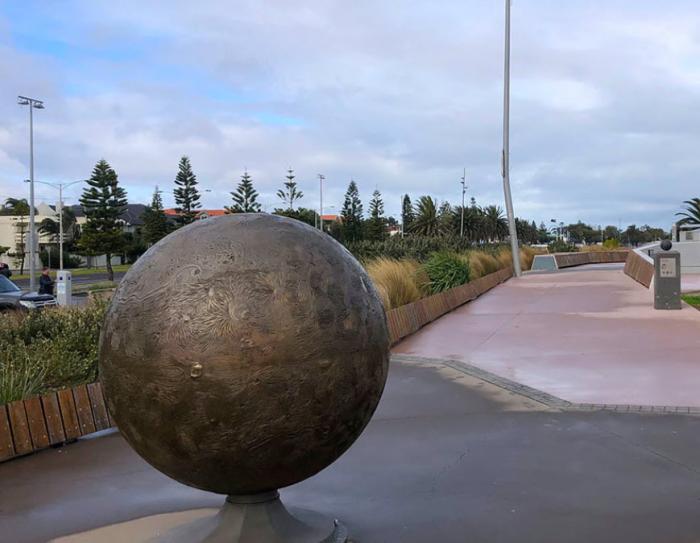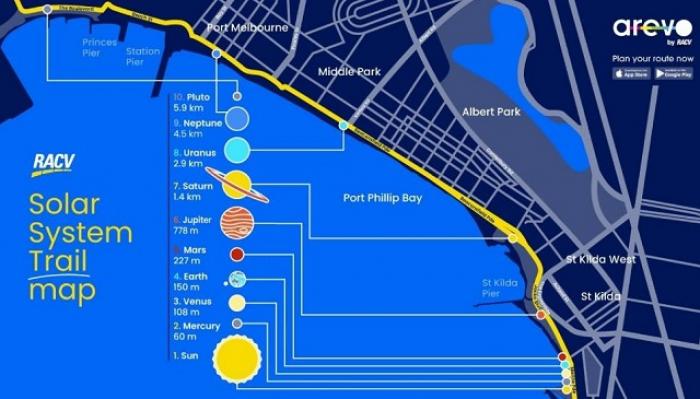St Kilda Solar System |

Public art: St Kilda Solar System
St Kilda Foreshore
The St Kilda Solar System stretches for 5.9 km along St Kilda's foreshore from St Kilda Marina, west to Port Melbourne.
Down by St Kilda's foreshore, you'll find a to scale replica of our Solar System, starting with the Sun in Marina Reserve.
It's a quick trip to the first five planets (the Earth being only 150 metres from the Sun), with the trail stretching 5.9 kilometres to dwarf planet Pluto in Port Melbourne.
The 1,392,000 kilometre diameter of the sun is rendered into 139 centimetres and each millimetre you walk represents 1000 kilometres.
As far as walking trails go, this one is truly out of this world.
Step into outer space, without leaving Melbourne
SOLAR SYSTEM TRAIL
 Every millimetre you walk is 1000 kilometres.
Every millimetre you walk is 1000 kilometres. Every centimetre you walk is 10,000 kilometres.
Every centimetre you walk is 10,000 kilometres. Every metre you walk (one and a half steps) is 1,000,000 kilometres.
Every metre you walk (one and a half steps) is 1,000,000 kilometres. When you walk 5.9 kilometres from the Sun (Marina Reserve) to Pluto (Port Melbourne), you have travelled 5.9 billion kilometres.
When you walk 5.9 kilometres from the Sun (Marina Reserve) to Pluto (Port Melbourne), you have travelled 5.9 billion kilometres.
 START St Kilda
START St Kilda FINISH Port Melbourne
FINISH Port Melbourne LENGTH 5.9 kilometres
LENGTH 5.9 kilometres TIME Up to 90 minutes
TIME Up to 90 minutesTrail Map
Trail Map (PDF)

THE SOLAR SYSTEM MODEL
Navigate the solar system from the sun to the outer planets by following the bike and walking trail on the City of Port Phillip's foreshore.
In 2008 artists and scientists constructed a model of our solar system to a scale of one to one billion between St Kilda and Port Melbourne. Instead of navigating 4.5 billion kilometres from the sun to Neptune, and 5.9 billion kilometres from the sun to Pluto, you only travel 4.5 kilometres and 5.9 kilometres.
The foreshore has always been a superb location to view the un setting on the western horizon. Port Phillip Bay's crescent shape is perfect for a model where the 'sun' can be viewed from every one of the nine model locations.
START AT THE SUN
The trail starts at the sun sculpture, near the white lighthouse in Marina Reserve at the south end of St Kilda Beach. From the sun follow the foreshore trail north to visit the eight planets, accurately scaled to size and distance.
You can walk to the first five planets within twenty minutes. The furthest object, the dwarf planet Pluto at Sandridge Beach, can be reached within ninety minutes.
OUR ENVIRONMENT
Seeing the Earth on a human scale shows its immense isolation and vulnerability. In the vastness of space it is imperative for us to care for this precious environment of our only home.
SAND IN SPACE
The beach is a clue to the immensity of the universe. Pick up a handful of sand as you walk. It contains about 10,000 grains. Imagine that each grain is one star like our sun. Reflect that there are about ten times as many stars as grains of sand on all the world's beaches and deserts combined.
There are an estimated 70,000 million million million stars (seven followed by twenty-two zeros) in the observable universe.
Our sun is just one star of more than 300 billion stars in the Milky Way galaxy. Our galaxy is just one of more than 100 billion galaxies in the observable universe which is probably a minuscule fraction of the actual number
SOLAR SYSTEM TRAIL
Our solar system consists of the sun, eight planets, hundreds of moons and countless asteroids, comets, dwarf planets and other small bodies.
It formed about 5 billion years ago from a cloud of gas and dust left behind by dying stars. This cloud gravitationally collapsed into a rotating disk. Most of the material gathered at the centre to form the sun. Smaller amounts further out formed the planets. As planets orbited they swept the area around them clear of rock.
Of the eight planets, the inner four are rocky while the outer planets - Jupiter, Saturn, Uranus and Neptune - are gas giants.
Spacecraft missions since the mid-1970s have hugely increased our knowledge of the planets. Spacecraft cannot land on the gas giants, only on some of their moons, for instance, the Huygens Probe that landed on Titan, Saturn's largest moon in 2005.
Visit heritage.portphillip.vic.gov.au for more information about cultural heritage programs and activities in the City of Port Phillip.
You can also contact us by phone via our ASSIST centre on 03 9209 6777.
Solar Sytem Trail Project (2008)
This project, combining educational, environmental and artistic themes, was based on an initial temporary model located on the foreshore in 2005. The City of Port Phillip, Lonely Planet Foundation, Chris Lansell of Monash University, artist Cameron Robbins, Scienceworks and the Astronomical Society of Victoria, collaborated
to bring that vision to reality in 2008.
Special thanks to Barry Cleland and Barry Adcock, Astronomical Society of Victoria, for their advice and support.
Trail Map
Trail Map (PDF)
❊ Address ❊
⊜ Marina Reserve, St Kilda 3182 View Map
❊ Web Links ❊
➼ St Kilda Solar System
➼ www.visitmelbourne.com
➼ Solar System Trail St Kilda - Google
➼ 5.9 km Solar System Model Built to Scale - youtube.com
Disclaimer: Check with the venue (web links) before making plans, travelling or buying tickets.
Accessibility: Contact the venue for accessibility information.
Update Page








